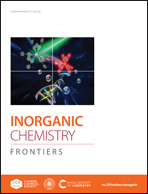Constructing electron transfer pathways and active centers over W18O49 nanowires by doping Fe3+ and incorporating g-C3N5 for enhanced photocatalytic nitrogen fixation†
Abstract
Global warming has caused us to seek a sensible strategy to replace the energy consumption of the Haber–Bosch approach in manufacturing ammonia. NH3 is utilized in agriculture to produce fertilizer to gratify the rapid increase of human food demand. Herein, we report the construction of a heterojunction that adopted g-C3N5 and Fe3+-doped W18O49 (Fe-W18O49) for photocatalytic nitrogen fixation for the first time. The surface of g-C3N5 was porous and fluffy, and its band gap energy was relatively narrow, which could adjust the absorption range of the hybrid and improve the utilization efficiency of light energy. Fe-W18O49 nanowires were rich in oxygen vacancies (OVs) that provided sufficient active sites for nitrogen adsorption and activation. The generated complex had excellent electron and hole separation ability, and the photogenerated carriers were successfully distributed to two different substances, which significantly elevated the nitrogen fixation capacity of the catalyst. The formation rate of ammonia reached 131.6 μmol g−1 h−1 when Fe-W18O49/g-C3N5 was employed as the catalyst for nitrogen fixation, which was obviously enhanced as compared with pure g-C3N5 or Fe-W18O49. This has provided the possibility to construct an inexpensive nitrogen fixation catalyst with outstanding catalytic properties.



 Please wait while we load your content...
Please wait while we load your content...